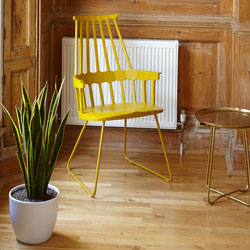 Plants brighten up any room, help clean the air and bring a bit of nature inside, but indoor spaces rarely have the same levels of bright, natural light many plants enjoy in their native habitats. Without adequate light, a plant’s foliage may be dull or turn yellow or brown, growth will be slow and flowers may fail to bloom. Choosing low light houseplants is an ideal solution for any indoor space, and there are many beautiful plants that can thrive in a dim environment.
Plants brighten up any room, help clean the air and bring a bit of nature inside, but indoor spaces rarely have the same levels of bright, natural light many plants enjoy in their native habitats. Without adequate light, a plant’s foliage may be dull or turn yellow or brown, growth will be slow and flowers may fail to bloom. Choosing low light houseplants is an ideal solution for any indoor space, and there are many beautiful plants that can thrive in a dim environment.
20 Best Houseplants for Low Light
There are many reasons to opt for low light houseplants. Some rooms, such as bedrooms and bathrooms, generally have lower than average light levels. Some homeowners use window shades, blinds or curtains for temperature control, which reduces the light available for indoor plants. Even bright rooms may have dim corners or shadowed spaces where light isn’t as intense. The exposure of any window also affects the sunlight it brings indoors, with north and west windows generally having lower light than south and east windows. Changing seasons also changes how much sunlight comes through any window, with less light available to indoor plants in fall and winter. Fortunately, there are many outstanding houseplants that can grow well in lower light conditions. While the best plants for your home will also vary based on humidity conditions and the care you can provide, houseplants that don’t mind lower light include:
- Begonia (Begonia)
- Bromeliads (Aechmea)
- Cast Iron Plant (Aspidistra)
- Chinese Evergreen (Aglaonema)
- Corn Plant (Dracaena fragrans)
- Dumb Cane (Dieffenbachia)
- Heartleaf Philodendron (Philodendron hederaceum)
- Lucky Bamboo (Dracaena)
- Maindenhair Fern (Adiantum)
- Parlor Palm (Chamaedorea elegans)
- Peace Lily (Spathiphyllum wallisii)
- Peperomia (Peperomia)
- Ponytail Palm (Beaucarnea recurvata)
- Pothos (Epipremnum aureum)
- Prayer Plant (Calathea)
- Rubber Plant (Ficus elastica)
- Snake Plant (Sansevieria)
- Spider Plant (Chlorophytum)
- Sword Fern (Polystichum munitum)
- ZZ Plant (Zamioculcas zamiifolia)
These are just a few of the most widespread, popular indoor plants that can do well with lower light levels. Check at your local nursery or garden center for additional varieties that are adapted to your region’s climate, especially during the winter months when houseplants are much more widely available.
Caring for Low Light Houseplants
It is important to note that whatever type of houseplant you choose, a designation as “low light” does not mean the plant can thrive in darkness. All plants need some light, but low light plants can still thrive in indirect or filtered light rather than several hours of bright sunlight each day. To give your low light plant the very best indoor habitat, you will also need…
- A proper pot or other container.
The pot will need to be the right size for the plant and its anticipated growth, without being too big or too small. Adequate drainage is also essential to prevent root rot and other care difficulties. - Suitable soil or potting mix.
Garden soil has too many contaminants to be good for houseplants, but choose a soil with good nutrition for the type of plant it will nurture. Add coir, peat or other potting material if necessary to adjust the soil composition. - Proper watering.
Inadequate water or overwatering can both be deadly for houseplants. Know what water your plant needs and adjust the watering schedule based on the plant’s size and seasonal needs throughout the year. Watering gauges or automatic watering tools can help you be sure you aren’t drowning or drying out your houseplants. - Regular feeding.
Because houseplants rely on the same soil and can’t stretch their roots out to seek extra nutrition, regular fertilizing is essential. Choose the proper fertilizer for the plant type and feed gently rather than risk burning delicate roots with overfeeding. Slow-release fertilizers formulated for indoor plants are one of the best options. - Increased humidity.
Indoor air is often much drier than the air outside, and houseplants can dry out more quickly without the proper humidity. Adding a humidifier in a room with houseplants, grouping plants together, misting regularly and providing a humidity tray are all ways to help. - Occasional dusting.
With no regular breezes to blow away debris, houseplants can become dull and dingy without being dusted, and dust can clog their pores. Use a soft, clean cloth to gently wipe the foliage, or give plants an occasional shower to rinse away unwanted dust.
Every home can be made brighter with houseplants, even in darker rooms where there wouldn’t seem to be enough light. By choosing the right low light houseplants and caring for them appropriately, even a shadowy corner of your home can be a restful bit of nature.




